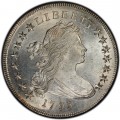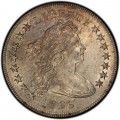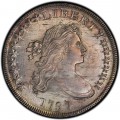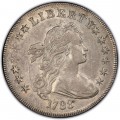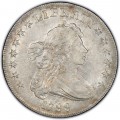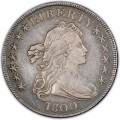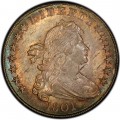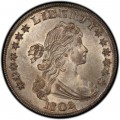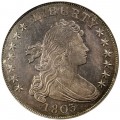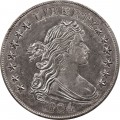- United States Coins
- Draped Bust Silver Dollars
Draped Bust Silver Dollars
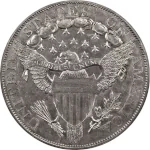 The 1795 Flowing Hair dollar was replaced by a new design, the Draped Bust dollar, by the end of the year. The first Draped Bust dollars were rolling off the presses in late 1795, adopting the same eagle reverse as is seen on the Flowing Hair dollars. In 1798, the original eagle motif on the reverse of the silver dollar was replaced with a larger heraldic eagle, which stayed on the coin for the remainder of the Draped Bust dollar series.
The 1795 Flowing Hair dollar was replaced by a new design, the Draped Bust dollar, by the end of the year. The first Draped Bust dollars were rolling off the presses in late 1795, adopting the same eagle reverse as is seen on the Flowing Hair dollars. In 1798, the original eagle motif on the reverse of the silver dollar was replaced with a larger heraldic eagle, which stayed on the coin for the remainder of the Draped Bust dollar series.
The most common Draped Bust silver dollars were made from 1798 through 1800, with 1799 representing the high-water mark for all early American dollar coins. In 1799, a whopping 423,515 pieces were minted. While this is a large number of coins, the 1799 Draped Bust dollar is still considered a very scarce issue these days, with fewer than perhaps 10,000 surviving. As is the case for all early American dollar coins, most surviving specimens are in rough shape and exhibit damage, and the relatively few problem-free, well-circulated pieces in existence easily sell for $1,000 to $1,150.
The last Draped Bust silver dollars of the original run were struck in 1804, but these are not the famous, rare 1804 Draped Bust dollars that most coin collectors desire for their collections. Rather, they are 1803-dated silver dollars representing the official end of the series as a circulating type. The headlining 1804 dollars, which are known as the King of American Coins, were actually made in the mid 1830s for inclusion in special proof sets that were given to overseas officials as diplomatic gifts.
Below is a list of Draped Bust Silver Dollar info sheets for each year of issue. Each info sheet includes detailed pricing and mintage numbers for each variant.
-
{{#owner}}
-
{{#url}}
{{#avatarSrc}}
{{name}} {{/url}} {{^url}} {{#avatar}} {{& avatar}} {{/avatar}} {{name}} {{/url}} - {{/owner}} {{#created}}
- {{created}} {{/created}}

